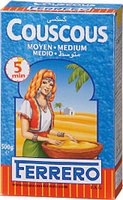 After various experiments, I always use the following method for preparing the couscous (about 75 g for each of us), despite what packet instructions may say. (Most couscous on sale here is pre-cooked, and does not need the steaming that recipes may specify). I pour boiling water over it until it is soaked, stopping before the water level rises above the level of the grains. I cover the dish and put it into a hot oven -- it does not matter how hot -- for five minutes. The grains emerge in a solid clump, but separate when you stir in other ingredients, particularly oily ones.
After various experiments, I always use the following method for preparing the couscous (about 75 g for each of us), despite what packet instructions may say. (Most couscous on sale here is pre-cooked, and does not need the steaming that recipes may specify). I pour boiling water over it until it is soaked, stopping before the water level rises above the level of the grains. I cover the dish and put it into a hot oven -- it does not matter how hot -- for five minutes. The grains emerge in a solid clump, but separate when you stir in other ingredients, particularly oily ones.I think that a couple of tbsps of pine nuts, which I toast in a dry saucepan, adds a lot of interest to the bland grains. I like parsley in there too. Last night, I roasted cubes of butternet squash, tossed with olive oil, cumin, salt and pepper; I added mushrooms and garlic to the tin with 15 minutes (of about 45) to go. I also stirred in some cold chicken. I divided the mixture in half, and stirred a tsp of harissa into my portion.
The mushrooms were a mistake: I should remember that when you cook them in oil or butter and let them get cold they acquire an unappealing -- greasy and rubbery -- texture.
3 comments:
I reckon you need to go a couple of cms above the level of the cous cous. It always absorbs the excess liquid without going too soggy - but too little liquid and you're left with rather hard grains. And it doesn't seem to make much difference whether you use boiling, warm or even cold water?
A couple of cms extra would certainly be too much for the couscous brand (the one illustrated) I use. It would remain damp and clumpy, and be too soft. But I use boiling water; otherwise, I find, the grains remain gritty.
I use that brand too and put in boiling water to a bit less than 1cm above. If I'm making a sauce (I like my cous cous with lots of sauce, I let the grains absorb the water and then tip them into a sieve over the sauce pan and cover the whole lot with a plate - - that way they get fluffy and absorb some of the flavours (and keep warm until I'm ready).
Post a Comment